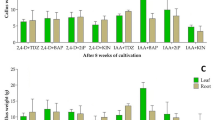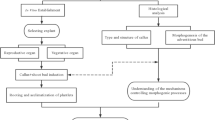Abstract
IN the growing root the pericycle is the site of the interesting morphogenetic activity, the initiation of lateral root primordia. This tissue also participates in the initiation of vascular cambium, which leads to the production of the secondary tissues of the root. For the investigation of the factors which initiate these activities in the pericycle and lead to the formation of organized tissues such as root primordia or cambium, it is desirable to have pericycle tissue isolated from the morphogenetic influence of neighbouring tissues. Surgical isolation would be almost impossible because of the small number of cells involved and the risk of injury.
This is a preview of subscription content, access via your institution
Access options
Subscribe to this journal
Receive 51 print issues and online access
$199.00 per year
only $3.90 per issue
Buy this article
- Purchase on Springer Link
- Instant access to full article PDF
Prices may be subject to local taxes which are calculated during checkout
Similar content being viewed by others
References
Goldacre, P. L., Austral. J. Biol. Sci., 12, 388 (1959).
Steward, F. C., Mapes, M. O., and Mears, K., Amer. J. Bot., 45, 705 (1958).
Torrey, J. G., and Shigemura, Y., Amer. J. Bot., 44, 334 (1957).
Author information
Authors and Affiliations
Rights and permissions
About this article
Cite this article
GOLDACRE, P., UNT, H. & KEFFORD, N. Cultivation of Isolated Tissue derived from the Pericycle of Roots. Nature 193, 1305–1306 (1962). https://doi.org/10.1038/1931305b0
Issue Date:
DOI: https://doi.org/10.1038/1931305b0
This article is cited by
-
Atypisches Waschtum isolierter in vitro kultivierter Wurzeln von Solanum laciniatum Ait
Die Naturwissenschaften (1964)
Comments
By submitting a comment you agree to abide by our Terms and Community Guidelines. If you find something abusive or that does not comply with our terms or guidelines please flag it as inappropriate.



